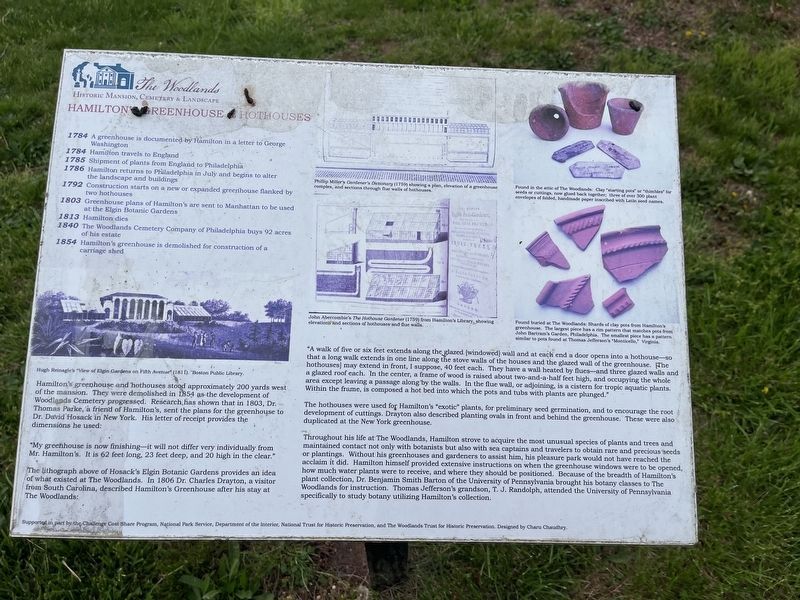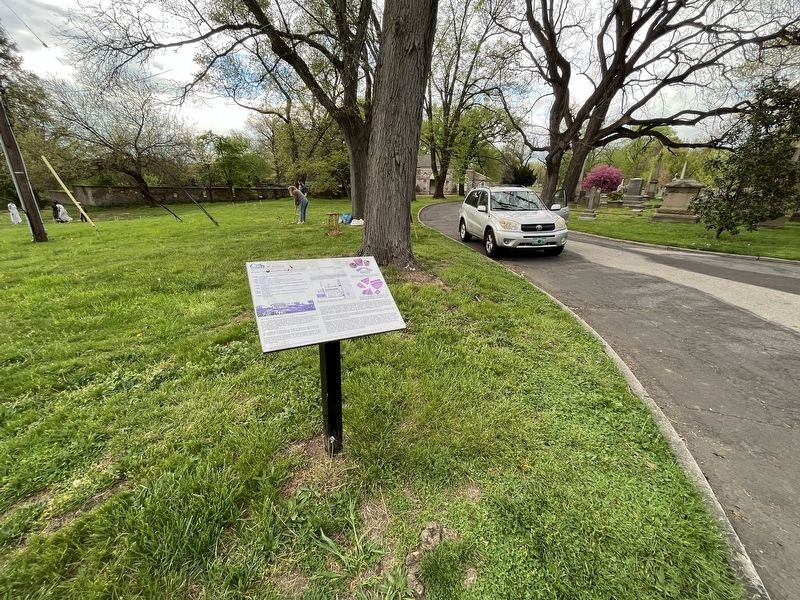University City in Philadelphia in Philadelphia County, Pennsylvania — The American Northeast (Mid-Atlantic)
Hamilton's Greenhouses & Hothouses

Photographed By Devry Becker Jones (CC0), April 15, 2023
1. Hamilton's Greenhouses & Hothouses Marker
1784 A greenhouse is documented by Hamilton in a letter to George Washington.
1784 Hamilton travels to England.
1785 Shipment of plants from England to Philadelphia.
1786 Hamilton returns to Philadelphia in July and begins to alter the landscape and buildings.
1792 Construction starts on a new or expanded greenhouse flanks by two hothouses.
1803 Greenhouse plans of Hamilton's are sent to Manhattan to be used at the Elgin Botanic Gardens.
1813 Hamilton dies.
1840 The Woodlands Cemetery Company of Philadelphia buys 92 acres of his estate.
1854 Hamilton's greenhouse is demolished for construction of a carriage shed.
Hamilton's greenhouse and hothouses stood approximately 200 yards west of the mansion. They were demolished in 1854 as the development of Woodlands Cemetery progressed. Research has shown that in 1803, Dr. Thomas Parke, a friend of Hamilton's sent the plans for the greenhouse to Dr. David Hosack in New York. His letter of receipt provides the dimensions he used:
"My greenhouse is now finishing—it will not differ very individually from Mr. Hamilton's. It is 62 feet long, 23 feet deep, and 20 high in the clear."
The lithograph above of Hosack's Elgin Botanic Gardens provides an idea of what existed at The Woodlands. In 1806 Dr. Charles Drayton, a visitor from South Carolina, described Hamilton's Greenhosue after his stay at The Woodlands:
"A walk of five or six feet extends along the glazed [windowed] wall and at each end a door opens into a hothouse—so that a long walk extends in one line along the stove walls of the houses and the glazed wall of the greenhouse. [The hothouses] may extend in front, I suppose, 40 feet each. They have a wall heated by flues—and three glazed walls and a glazed roof each. In the center, a frame of wood is raised about two-and-a-half feet high, and occupying the whole area except leaving a passage along by the walls. In the flue wall, or adjoining, is a cistern for tropic aquatic plants. Within the frame is composed a hot bed into which the pots and tubs with plants are plunged."
The hothouses were used for Hamilton's "exotic" plants, for preliminary seed germination, and to encourage the root development of cuttings. Drayton also described ovals in front and behind the greenhouse. These were also duplicated at the New York greenhouse.
Throughout his life at The Woodlands, Hamilton strove to acquire the most unusual species of plants and trees and maintained contact

Photographed By Devry Becker Jones (CC0), April 15, 2023
2. Hamilton's Greenhouses & Hothouses Marker
Erected by The Woodlands Foundation.
Topics. This historical marker is listed in these topic lists: Architecture • Cemeteries & Burial Sites • Horticulture & Forestry • Science & Medicine. A significant historical year for this entry is 1784.
Location. 39° 56.755′ N, 75° 12.231′ W. Marker is in Philadelphia, Pennsylvania, in Philadelphia County. It is in University City. Marker can be reached from the intersection of Woodland Avenue and Chester Avenue, on the left when traveling west. Touch for map. Marker is at or near this postal address: 4000 Woodland Ave, Philadelphia PA 19104, United States of America. Touch for directions.
Other nearby markers. At least 8 other markers are within walking distance of this marker. Hamilton's Carriage House & Stable (within shouting distance of this marker); Commodore David Porter (about 500 feet away, measured in a direct line); Philadelphia Orchard Project (approx. 0.2 miles away); William Hamilton's Schuylkill River Residence & Pleasure Gardens (approx. 0.2 miles away); The Woodlands (approx. 0.2 miles away); Woodlands Cemetery (approx. 0.2 miles away); Paul Philippe Cret (approx. 0.2 miles away); Philadelphia College of Pharmacy and Science (approx. ¼ mile away). Touch for a list and map of all markers in Philadelphia.
Credits. This page was last revised on April 16, 2023. It was originally submitted on April 16, 2023, by Devry Becker Jones of Washington, District of Columbia. This page has been viewed 70 times since then and 12 times this year. Photos: 1, 2. submitted on April 16, 2023, by Devry Becker Jones of Washington, District of Columbia.